Discover everything you need to know before visiting Bali’s revered Besakih Temple with our concise visitor guide. As the island’s largest and most sacred temple complex, Besakih offers a rich cultural and spiritual experience. This guide provides practical tips covering transportation, the best times to visit, and proper etiquette. Uncover critical details about the temple’s architecture, facilities, and nearby attractions, ensuring a seamless and meaningful journey. Whether you’re here for spiritual enrichment or photography, our guide helps you make the most of your trip to Besakih Temple in Karangasem.
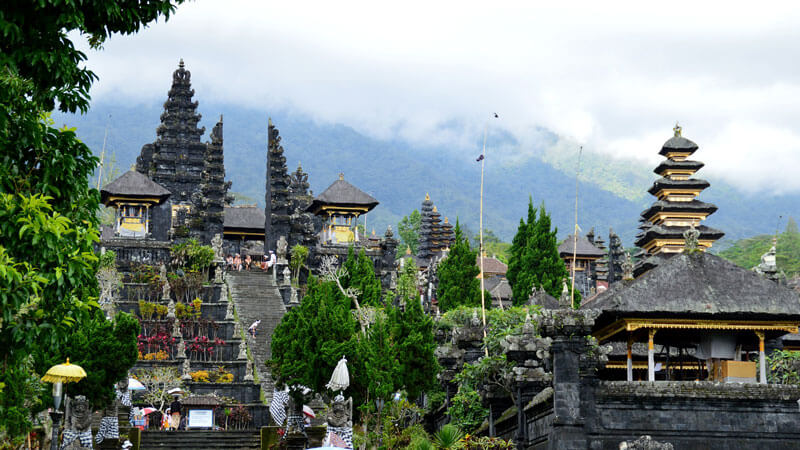
Table of Contents[Hide][Show]
Besakih Temple Visitors Guide: Maximizing Your Visit+−
- Optimal Times for a Serene Visit
- Arriving at Besakih Temple: The Essentials Visitor’s Guide
- Besakih Temple, Karangasem, Bali Entrance Fee
- Vehicle Parking Cost
- Visitors’ Guide For Cultural Engagement, Tips & Etiquette
- Engaging Deeply with Besakih
- Visitors’ Guide For Navigating the Besakih Temple
- Weather Wisdom for Comfort
- Navigating Facilities for Comfort
- What to Expect
- Guide to Photographing Besakih Temple
- Besakih Temple Visitors Guide: Insights from Fellow Travelers
- Spiritual Experience: A Holiday at Besakih Temple
Above all, as you plan your visit to the spiritual epicenter of Bali, don’t miss the chance to explore the secret beauty of East Bali.
Besakih Temple: Embraced by Mount Agung
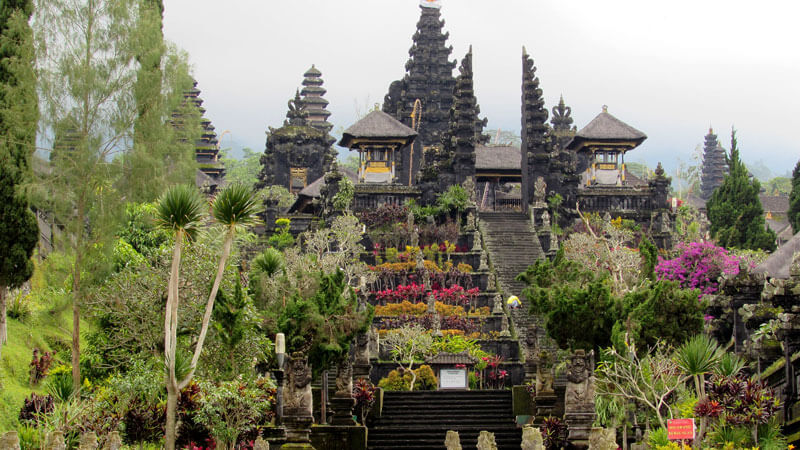
Before delving deeper into the history and grandeur of Besakih Temple, let’s begin by understanding its unique location. The sacred complex of Besakih is nestled on the Mount Agung western slopes, Bali’s highest mountain, revered as a sacred peak. The placement of the Besakih temple complex at this altitude offers breathtaking views and symbolizes the harmony between nature and spirituality.
Origins of Besakih Temple: Creators and the Sacred Complex
Besakih Temple, often nicknamed ‘The Mother of Temples’ or ‘Ibu dari Semua Pura di Bali’, is majestically a center of spirituality and architecture in Karangasem Regency, Bali.
This temple complex, situated on the slopes of Mount Agung, encompasses 19 temples, including Penataran Agung Besakih and Pura Basukian. Within this complex, Pura Penataran Agung is the central temple, surrounded by companion temples with unique spiritual values.
Pura Basukian, an integral part of this complex, is where Hyang Rsi Markendya received divine revelations, marking the origin of Hindu Dharma in Bali. According to legend, Rsi Markandeya, a Hindu sage from India, was called to establish Besakih Temple in 1284 after a mystical spiritual experience in the Dieng Plateau.
This has been an essential place of worship since the Gelgel dynasty in the 15th century, symbolizing Bali’s timeless faith.
For more in-depth information about the rich history of the sacred Besakih complex, please click the link to the ‘Mother of Temple’ history on Wikipedia.
The Origin of the Name ‘Besakih’
Did you know the name ‘Besakih’ has deep roots in Bali’s history and mythology? ‘Besakih’ derives from Sanskrit’ wasuki’, or in Old Javanese’ basuki’, meaning ‘safe’. Moreover, it’s also linked to the legendary Naga Basuki, a dragon in Hindu mythology, considered a balancer of Mount Mandara. This name reflects the essence of Besakih Temple as a place of refuge, peace, and profound spirituality.
After marveling at the grandeur of the sacred Besakih complex, continue your spiritual exploration by visiting the Top 10 Temples in Bali, each with its unique story and charm.
Architecture of Besakih: Symbolism and Aesthetics
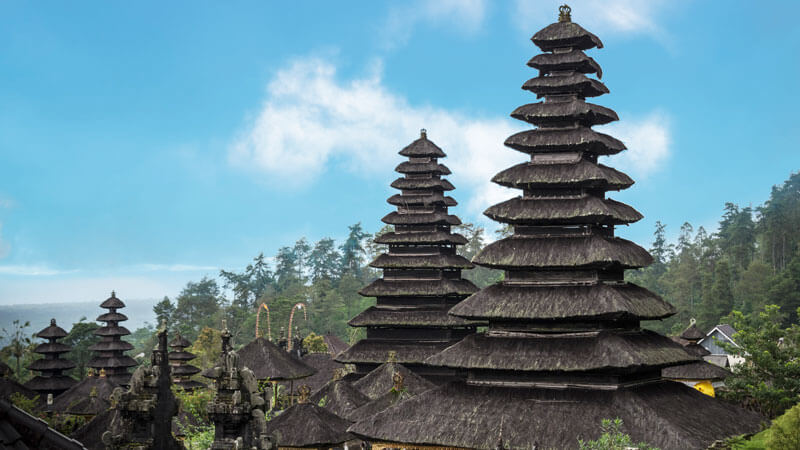
The architecture of Besakih Temple, with its Meru towers and Kori Agung gates, creates a cosmic vision and illustrates the transition from the material world to enlightenment.
The temple’s layout and structure offer deep insight into the diversity of spiritual practices in Bali and invite visitors to reflect on the stories and devotion embedded in its history. Every architectural aspect of Besakih provides a profound worship experience, reflecting Bali’s spiritual and cultural heritage.
This guide aims to enlighten you about the uniqueness and local wisdom of Besakih Temple during your visit.
Besakih Temple Karangasem Bali Visitors Guide
Embark on a culturally enriching journey to Besakih Temple Bali, Bali’s spiritual gem, nestled on the slopes of Mount Agung (Google Maps). Above all, this guide is tailored to provide practical advice, ensuring a smooth and memorable experience.
Getting to Besakih Temple: Practical Transportation Options
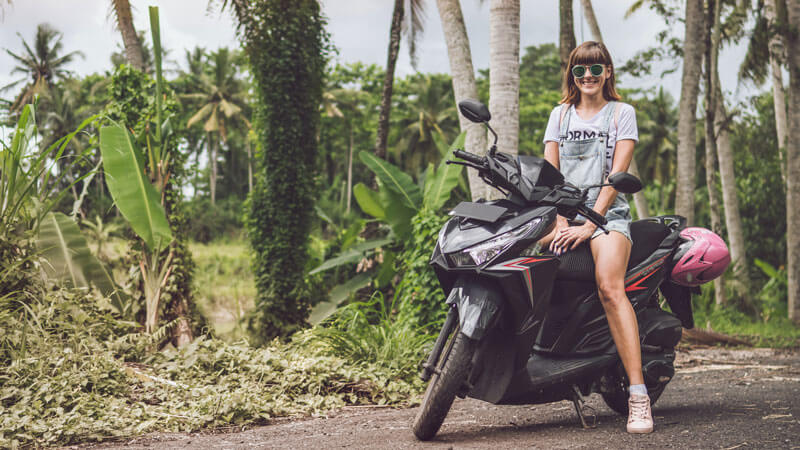
Besakih Temple, Bali, a serene sanctuary amidst Bali’s panoramic landscapes, is accessible via a 2-hour drive from Ubud and slightly less from Seminyak, Kuta, or Denpasar. As you traverse Bali’s scenic countryside, the adventure unfolds along mountainous routes and lush surroundings.
- Rent a Car: Ideal for those valuing independence and comfort. Ensure you’re acquainted with local driving customs and have the necessary permits. Remember, driving in Bali might differ from what you’re used to at home.
- Hire a Private Driver: Opt for a stress-free journey with a private driver who navigates and shares insights into Besakih’s historical and cultural tapestry. This option particularly appeals to travelers from regions where personal hospitality is highly valued. For more details on navigating Bali at your own pace, consider our guide on renting a car with a driver or driving yourself around Bali.
- Tour Packages: Consider a tour package for a structured visit with expert guidance. These often include comprehensive cultural explanations, making them favorites for those who appreciate detailed narratives and organized plans.
- Scooter Rentals: Scooters are suitable for the bold and experienced and offer an exhilarating way to experience Bali’s natural beauty. Prioritize safety and ensure you’re well-versed in local traffic regulations.
These Bali transportation options cater to various preferences and needs, ensuring your journey to Besakih Temple is as enriching as the destination. Enjoy the blend of spiritual insight, architectural grandeur, and natural beauty that awaits you at this sacred site.
Besakih Temple Visitors Guide: Maximizing Your Visit
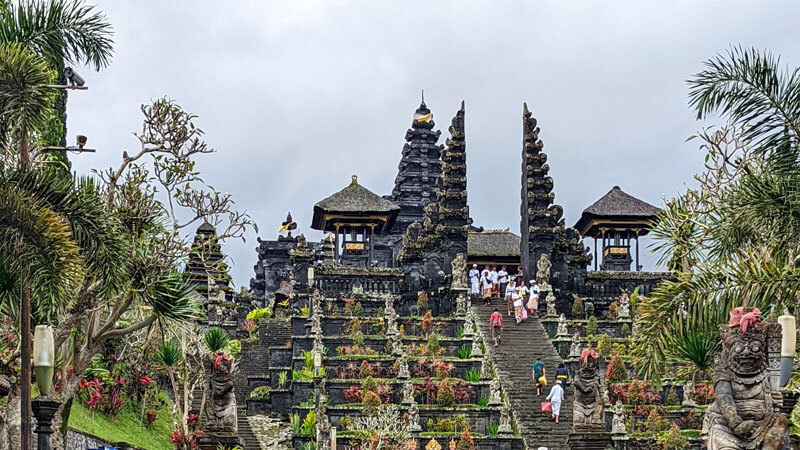
Embark on a journey to the spiritual heart of Bali at Besakih Temple with this essential guide, crafted to ensure a respectful, engaging, and enriching experience. From planning your arrival to navigating the temple’s sacred grounds, discover the best practices for a memorable visit.
Optimal Times for a Serene Visit
- Best Hours: For a peaceful experience, visit early morning or late afternoon when the temple’s serene aura is most palpable.
- Weekday Visits: Fewer weekday visitors mean a more intimate encounter with Besakih’s grandeur.
- Ceremonial Visits: Hindu ceremonies offer vibrant cultural showcases but attract larger crowds. Balance your preference for tranquillity with the desire for a unique experience.
Arriving at Besakih Temple: The Essentials Visitor’s Guide
- Temple Opening Hours: Open from 7 am to 6 pm daily.
- Ease Your Climb: Consider riding the buggy (golf cart) for a convenient ascent, especially after a long journey.
Besakih Temple, Karangasem, Bali Entrance Fee
| Visitor Type | Entrance Fee |
|---|---|
| International Visitors | IDR 150,000 per person |
| Domestic Visitors | IDR 80,000 per person |
Note On Admission
- Before visiting Besakih Temple, please check admission prices, as they are subject to change.
- Additionally, children under six years of age receive free admission.
- The ticket prices listed were updated on November 11, 2025.
Making the Most of Your Entrance Fee
Your fee includes:
- A sarong for temple entry
- A one-way buggy ride from the car park
- The insightful company of an official guide
Vehicle Parking Cost
| Vehicle Type | Parking Fee |
|---|---|
| Scooter | IDR 5,000 |
| Car | IDR 10,000 |
| Bus | IDR 50,000 |
Visitors’ Guide For Cultural Engagement, Tips & Etiquette
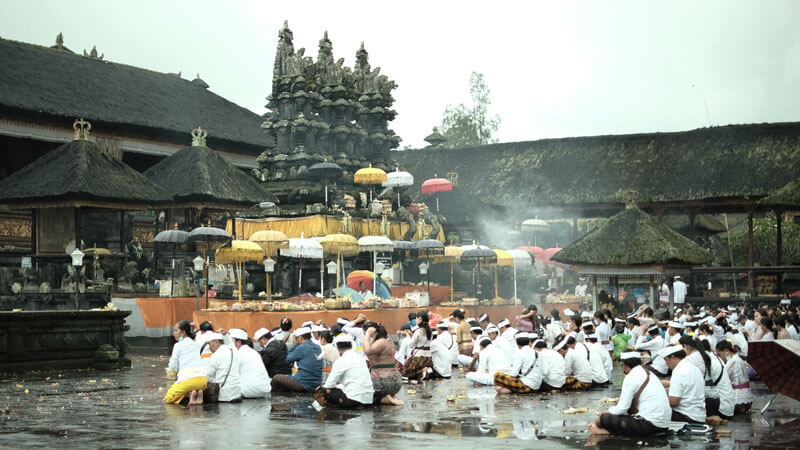
- Dress for Comfort: Opt for light clothing suitable for Bali’s climate and the temple’s steps. Modesty is vital; cover shoulders and knees, and utilize the provided sarongs and sashes. Check out our simple guide to Bali temple dress codes.
- How to Behave: Maintain a quiet, gentle demeanor and heed temple staff guidance. Your respect fosters deeper cultural connections.
- Ceremonial Etiquette: Observe ceremonies from a respectful distance without flash photography. It’s about respect, not intrusion.
- Capture the Moment: Consider a professional photo of the iconic steps to encapsulate your Besakih journey.
- Language: While Balinese and Indonesian are the local languages, English is widely spoken in tourist areas. Learning a few basic phrases in Balinese can enhance your interaction with locals.
Engaging Deeply with Besakih
- Temple Dynamics: Besakih is a complex of 19 temples, with Pura Penataran Agung at its heart.
- Design Insights: The temple’s layout mirrors the Balinese cosmos. Stroll with this in mind to transform your walk into a cosmic journey.
Visitors’ Guide For Navigating the Besakih Temple
- Find Your Path: Guides can tailor the tour to your interests. Express your focus, whether it’s architecture, spirituality, or photography.
- Interacting with Wildlife: Admire local fauna from a distance and refrain from feeding them.
Weather Wisdom for Comfort
- Weather Wisdom: Visit between April and October for the best weather. Read more on the best time to visit Bali for vacation.
- Daily Patterns: Mornings are usually more straightforward, while afternoons might bring quick showers. Be prepared with layers and rain gear for Bali’s unpredictable climate.
- Climate Considerations: The temple is at a higher altitude, so the climate might be more relaxed. Carry a lightweight jacket or shawl, particularly if you’re visiting early in the morning or late in the evening.
Check the current weather at Besakih to plan your visit accordingly.
Navigating Facilities for Comfort
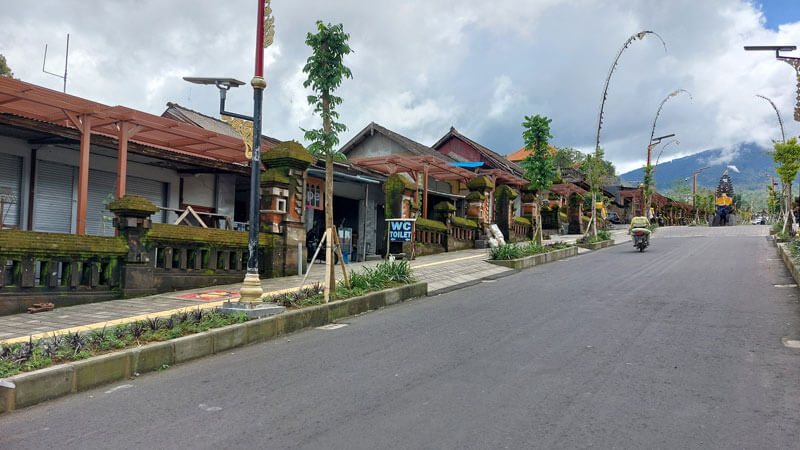
- Restroom Breaks: Use facilities before exploring; they’re less common in remote areas.
- Staying Nourished: Carry water and snacks, and explore local warungs to taste Bali.
- Taking a Pause: Utilize designated resting spots for reflection or a break.
What to Expect
- Physical Preparedness: Anticipate a physical climb and proceed in your comfort.
- Market Dynamics: Vendors offering snacks and souvenirs are part of the temple’s ecosystem. While no purchase is obligatory beyond your entrance fee, you can choose to support local businesses or politely decline.
- Flowers and Incense: You’ll meet locals who are offering flowers and incense near the entrance. It’s your call to buy, but engaging in this tradition can add a layer to your cultural experience. Just a heads-up, some might quote high prices – feel free to negotiate or kindly decline.
- Guide Tip: Consider a tip (around IDR 100,000) to show appreciation for your guide’s insights.
Read about what others have experienced during their visit to understand what to expect at Besakih. By adhering to these guidelines, your visit to Besakih Temple will introduce you to a significant cultural site and offer a deeper understanding of Bali’s spiritual and historical fabric.
After exploring Besakih, continue your spiritual and cultural journey with our complete guide to Bali’s famous temples and traditional villages.
Guide to Photographing Besakih Temple
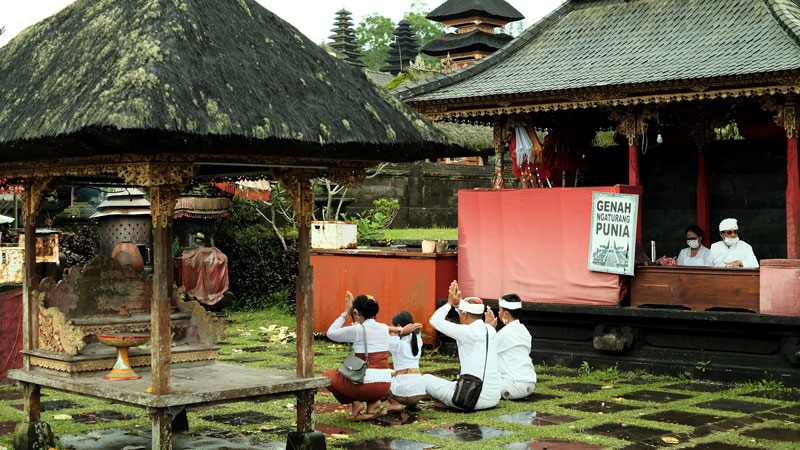
Visit the Agung Besakih area and capture its beauty and spiritual richness. Use our concise guide to photograph stunning views:
- Focus on Architecture: The iconic Meru towers with thatched roofs are an important spiritual symbol. When taking photos, notice how this structure stands out amidst its surroundings.
- Optimal Lighting: Utilize natural light during sunrise or sunset for a spiritual ambiance. During the day, sharp shadows can add dimension to your photos.
- Respect the Environment and Culture: Always ask for permission when photographing religious activities and avoid taking pictures in areas that disturb worshippers.
With this guide, you can immortalize the beauty of Besakih Temple while respecting its cultural and spiritual values.
Besakih Temple and Beyond: Quick Visitors Guide to Nearby Gems
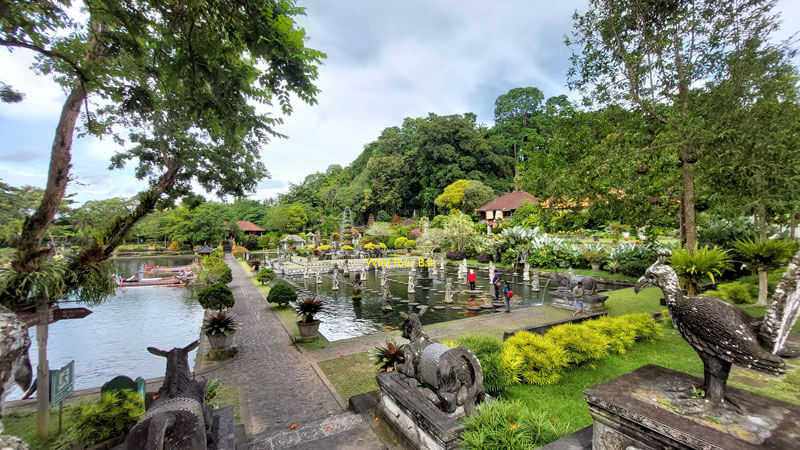
Essential Attractions Near Besakih Temple
- Goa Lawah (Bat Cave Temple): This cave temple is a spiritual and natural wonder, home to thousands of bats. It’s an intriguing sight that combines nature’s mystique with spiritual significance. Explore the mystique of Goa Lawah.
- Sidemen Valley: Immerse yourself in the serene beauty of Bali with its tranquil terraces and lush landscapes. It’s a perfect retreat for those seeking peace away from bustling tourist spots. Immerse yourself further in the serene beauty of Sidemen Valley.
- Tirta Gangga: This royal water garden is a mosaic of ornate fountains and pools. It’s an ideal spot for contemplation and experiencing the royalty of Balinese culture. Experience the royal grandeur of Tirta Gangga.
- Lempuyang Temple (Pura Luhur Lempuyang): Known as ‘The Gateway to Heaven,’ this ancient temple offers breathtaking views of Mount Agung. A spiritual journey here leads to panoramic vistas and a deep connection with Bali’s sacred history. Explore the serene beauty of Lempuyang Temple.
While exploring Bali’s spiritual sites, don’t miss the exciting story behind Tanah Lot Temple, another of Bali’s iconic spiritual landmarks.
Besakih Temple Visitors Guide: Insights from Fellow Travelers
- “Besakih is a spiritual odyssey. Remain aware of your surroundings, and immerse yourself fully to let the temple’s history and spirituality shape your visit.” – Shreyan.
- “Besakih connects the past with the present. Its streamlined entrance allows you to focus more on spiritual and cultural immersion.” – Brenda.
Spiritual Experience: A Holiday at Besakih Temple
As you embark on your journey to the sacred site on Mount Agung, remember that this is not just an ordinary visit; it’s a golden opportunity to witness Bali’s spiritual core. With our insights, you’ll be ready to create an unforgettable experience.
Whether you’re coming to seek tranquillity, marvel at architectural wonders, or deepen your cultural understanding, Besakih Temple awaits its beauty and uniqueness. Use this holiday guide as your toolkit, and let every moment in the majestic Besakih area enrich your perspective.
If it’s your first time in Bali and you’re wondering where else to go, here’s a guide on the best places to visit to help you plan an unforgettable journey.
Bahasa Indonesia:
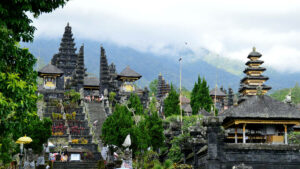
 Uluwatu Temple Bali [2025] Travel Guide: Tips and Must-See Highlights
Uluwatu Temple Bali [2025] Travel Guide: Tips and Must-See Highlights
We'd love to hear from you! Share your thoughts or experiences in the comments below!